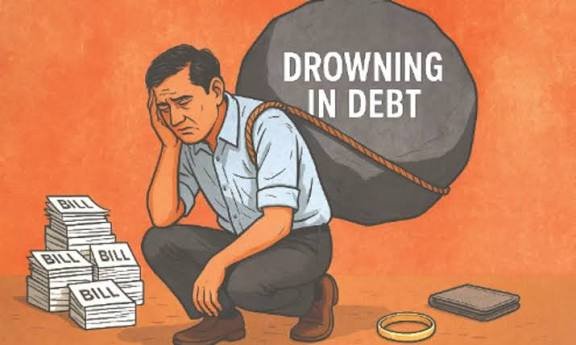Drowning in EMI Debt?
If you are struggling with overwhelming EMI debt, there are several practical strategies you can implement to regain financial control.
The key steps involve evaluating your situation, cutting expenses, increasing income, and communicating with your lenders.
Immediate Actions and Planning
Acknowledge and Assess: The first step is to face the situation without judgment. List all your debts, including interest rates, outstanding amounts, and monthly EMIs. This will help you understand the full scope of the problem.
Create a Strict Budget: Track every expense meticulously. Categorize spending into essentials (needs) and non-essentials (wants) and cut back aggressively on the latter.
A general guideline is for your total EMIs not to exceed 30-40% of your monthly income.
Build an Emergency Fund: Even small savings, like ₹1,000 a month, can start building a safety net. An emergency fund (ideally 3-6 months’ worth of expenses) is crucial to avoid taking on more debt in case of unexpected events like a job loss or medical emergency.
Debt Management Strategies:
Prioritize High-Interest Debts: Focus your extra funds on paying off debts with the highest interest rates first (e.g., credit card dues and personal loans, which can range from 24% to 48% annually). This is known as the “debt avalanche” method and minimizes your total interest payments over time.
Consolidate Your Loans: Consider combining multiple high-interest debts into a single loan with a lower interest rate, such as a personal loan or a top-up on an existing home loan. This simplifies repayment and can significantly reduce your monthly outflow.
Communicate with Lenders: Don’t wait until you default. Contact your bank or financial institution as soon as you anticipate a problem. They may offer options like temporarily extending your loan tenure to reduce the EMI, a grace period, or loan restructuring.
Use Windfall Gains Wisely: Any bonuses, tax refunds, or maturity proceeds from investments should be used for prepayment of your costlier debts.
Long-Term Solutions
Increase Your Income: Look for ways to supplement your income through freelancing, a side hustle, or monetizing a skill.
Sell Unused Assets: If necessary, consider selling assets like stocks, mutual funds, or gold to manage your liabilities.
Seek Professional Help: If the debt is overwhelming, reach out to a certified financial planner or a debt counseling center for tailored advice and help in creating a structured repayment plan.
Stay Disciplined: Getting out of debt requires discipline and a change in lifestyle. Avoid taking on new loans unless it is for debt consolidation at a lower rate.
In short:
• Buying on EMI frequently creates a debt trap and hidden monthly liabilities that can lead to financial instability.
• Paying interest on EMIs reduces long-term savings and shrinks your emergency fund or investment capacity.
• Defaulting or missing EMI payments brings heavy penalties and can severely lower your credit score, hurting future loan eligibility.
• Many people accumulate ₹5 lakh or more in debt through unchecked EMI purchases, resulting in extreme stress and forced asset sales in serious cases.
• Always check EMI affordability: keep total EMIs below 25-30% of your net monthly income, using a realistic budget.
•Avoid buying non-essential or luxury items on EMI, most impulse purchases today become sources of regret tomorrow.
• Build a cash reserve for emergencies; only borrow for crucial needs like health, education, or career growth.
• Don’t let social pressure push you into “status upgrades” via EMI short-term thrill often leads to long-term financial harm.
• Seek early financial advice if EMI bills pile up, consider debt consolidation and restructuring before matters get worse.
Team: Credit Money Finance

